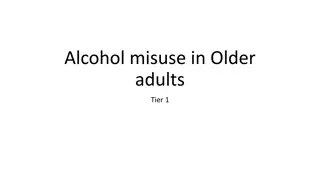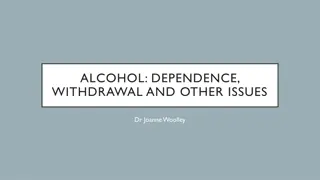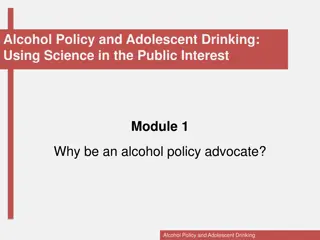Alcohol Advisory Council of New Zealand Presentation at AA Research Foundation Research Symposium
Dr. Craig Gordon from the Alcohol Advisory Council of New Zealand presented at the AA Research Foundation Research Symposium. The presentation took place on the 5th and 6th of September 2011 in Wellington, NZ. Dr. Gordon acknowledged Dr. Michael Regan from IFSTTAR, France, and Charlene Hallett, a Ph.D. student from IFSTTAR, France, for their contributions.
Download Presentation

Please find below an Image/Link to download the presentation.
The content on the website is provided AS IS for your information and personal use only. It may not be sold, licensed, or shared on other websites without obtaining consent from the author.If you encounter any issues during the download, it is possible that the publisher has removed the file from their server.
You are allowed to download the files provided on this website for personal or commercial use, subject to the condition that they are used lawfully. All files are the property of their respective owners.
The content on the website is provided AS IS for your information and personal use only. It may not be sold, licensed, or shared on other websites without obtaining consent from the author.
E N D
Presentation Transcript
Dr Craig Gordon Alcohol Advisory Council of New Zealand c.gordon@alac.org.nz Presentation at AA Research Foundation Research Symposium, 5-6thSeptember, 2011, Wellington, NZ
Acknowledgments Dr Michael Regan (IFSTTAR, France) Charlene Hallett (Ph.D. Student, IFSTTAR, France) Information presented based on: Regan, M.A., Hallett, C., and Gordon, C. (2011). Driver distraction and driver inattention: Definition, relationship and taxonomy. Accident Analysis and Prevention, 43, pp. 1771-1781. Gordon, C.P., and Regan, M.A. (2011). Driver distraction and inattention and their role in crashes and critical events. In Regan, M.A., Victor, T., and Lee, J.D., (Eds.), Driver distraction and inattention: Advances in research and countermeasures. England, UK: Ashgate (in preparation).
Outline Some definitions Examples of what studies include Some themes Possible framework *Views expressed are those of the authors and not necessarily Government policy
Inattention diminished attention to activities critical for safe driving in the absence of a competing activity (Lee et al, 2008) improper selection of information, either a lack of selection or the selection of irrelevant information (Victor et al, 2008) when the driver s mind has wandered from the driving task for some non-compelling reason (Craft and Preslopsky, 2009)
Distraction the diversion of attention away from activities critical for safe driving towards a competing activity (Lee et al, 2008) diversion of attention from driving, because driver is temporarily focusing on an object, person, task or event not related to driving (Hedlund et al, 2005) because some event, activity, object or person within [or outside] his vehicle, compelled or induced the driver s shifting of attention away from the driving task (Treat, 1980)
NHTSA GES, FARS, CDS Inattention includes Driver distraction Looked but didn t see incidents Fatigue Emotional conditions Physical conditions Driver distraction Non-driving related secondary task activity, inside or outside the vehicle Internal thought daydreaming, lost in thought NHTSA (2010), Stutts et al (2005)
In-depth crash studies Use human error categories Recognition error, decision error, performance error and non- performance error Recognition error category Inattention non-driving related internal thought only Driver distraction inside and outside the vehicle, non- driving secondary task activity Inadequate surveillance including looked but didn t see Does not include fatigue or emotional conditions Treat (1980); LTCCS Study; NMVCCS Study; Ascone, Lindsey & Varghese (2009)
In-depth crash studies (2) Inattention interference from internal thought Attentional competition interference between tasks relevant for driving Distraction interference from secondary task non-driving related activity Hoel et al (2010)
Naturalistic observational studies Inattention Secondary task activity (not necessary for performance of primary driving task) Fatigued or drowsy driving Driver related inattention to the forward roadway (i.e. checking speedometer, blind spots, mirrors, observing traffic during lane changes, looking for parking spots) Non-specific eye glance away from the forward roadway Dingus et al (2006); Klaueret al (2006)
International overview Driver distraction practice in 16 countries Most countries exclude fatigue or sleeping as distracted driving 4 countries include emotional distress/elation as distraction BUT 11 countries exclude emotional distress/elation as distracted driving (including NZ) 4 countries include emotional distress/elation as inattention NHTSA (2010b)
Driver inattention Narrowly defined as internal thought , or Covers many different elements that can include: A lack of attention Insufficient attention Cursory attention Selection of irrelevant information Looking away from the forward roadway Secondary task activities i.e. distraction Drowsiness and other driver state
Driver distraction Key elements considered in defining distraction Diversion of attention away from driving Diverted towards a competing activity, event, person, object Can be inside or outside the vehicle Always involves non-driving related activity Some include driving-related activity Some exclude internal thought Competing activity may compel or induce the driver to divert attention Implicit or explicit assumption that safe driving is adversely affected Regan, Hallett & Gordon (2011)
Possible Framework (Regan, Hallett and Gordon, 2011) Driver inattention insufficient, or no attention, to activities critical for safe driving Broadly defined, consists of different types of inattention driver distraction is one form
Possible Framework (Regan, Hallett and Gordon, 2011) Driver Inattention Diverted (Distraction) Restricted Misprioritised Neglected Cursory i.e. focusing on aspect/s of driving i.e. does not attend to critical activity i.e. hurried or cursory scanning i.e. microsleeps, change blindness
Driver diverted attention (Regan, Hallett and Gordon, 2011) Driver diverted attention akin to driver distraction The diversion of attention away from activities critical for safe driving toward a competing activity, which may result in insufficient or no attention to activities critical for safe driving
Driver Diverted Attention (Regan, Hallett and Gordon, 2011) Driver diverted attention Non-driving related Driving-related i.e. competing secondary task activity includes internal thought i.e. less-critical competing activity includes internal thought
The role of driver state Some studies/definitions (but not all) include driver state as inattention i.e. Fatigue, emotional distress/elation Question over criteria for inclusion what about other driver states such as alcohol and drugs? On what basis are some driver states included but other driver states not? In Regan et al model, treated as: Factors that give rise to different forms of inattention or Factors that influence the effects of different forms of inattention Specific state related factors (i.e. microsleeps, eyes closed) are included under restricted inattention
Key Points Different opinions about what distraction and inattention are and how they are defined We propose (Regan, Hallettand Gordon) Inattention has many forms distraction is one of them, need to discuss what the other forms are Our framework is part of the discussion Need to separate out activity from driver state Acknowledge current tools may not allow us to measure some of the differences in the framework
References Ascone, D., Lindsey, T., & Varghese, C. (2009). An examination of driver distraction as recorded in NHTSA databases. Traffic Safety Facts Research Note DoT HS 811-216. National Highway Traffic Safety Authority. Craft, R,H., & Preslopsky, B. (2009). Driver distraction and inattention in the USA large truck and national motor vehicle crash causation studies. Paper presented at the First International Conference on Driver Distraction and Inattention (28-29 September). Dingus, T., et al. (2006). The 100-car naturalistic driving study, Phase II Results of the 100-car field experiment. Report DoT HS 811- 593. National Highway Traffic Safety Authority. Hedlund, J., Simpson, H., & Mayhew, D. (2005). International conference on distracting driving: Summary of proceedings and recommendations (2-5 October). Hoel, J., Jaffard, M., & Van Elslande, P. (2010). Attentional competition between tasks and its implications. Paper presented at the European Conference on Human Centred Design for Intelligent Transport Systems (29-30 April). Klauer, S., et al. (2006). The impact of driver inattention on near-crash/crash risk: An analysis using the 100-car naturalistic driving study data. Report DoT HS 810-594. National Highway Traffic Safety Authority. LTCCS Study. (2006). Large truck causation study: Codebook. U.S. Department of Transportation: Federal Motor Vehicle Carrier Safety Administration. Lee, J.D., Young, K.L., & Regan, M.A. (2008). Defining driver distraction. In Regan, M.A., Lee. J.D., Young, K.L. (Eds.), Driver distraction: Theory, effects and mitigation. CRC Press Taylor & Francis Group. NHTSA. (2010a). Distracted driving 2009. Traffic Safety Facts Research Note DoT HS 811-379. National Highway Traffic Safety Authority. NHTSA. (2010b). Overview of results from the international traffic safety data and analysis group survey on distracted driving data collection and reporting. Traffic Safety Facts Crash Stats. Report No. DOT HS 811-404. National Highway Traffic Safety Authority. NMVCCS. Study (2008). National motor vehicle crash causation survey: Report to Congress. Report No DoT HS 811-059. National Highway Traffic Safety Authority. Stutts, J., et al. (2005). Guidance for implementation of the AASHTO strategic highway safety plan: Volume 14 a guide for reducing crashes involving drowsy and distracted drivers. NCHRP Report No 500, Volume 14. Transportation Research Board. Treat, J.R. (1980). A study of precrash factors involved in traffic accidents. The HSRI Review, 10(1). Victor, T.W., Engstrom, J., & Harbluk, J.L. (2008). Distraction assessment methods based on visual behaviour and event detection. In Regan, M.A., Lee, J.D., Young, K.L. (Eds.), Driver distraction: Theory, effects and mitigation. CRC Press Taylor & Francis Group.






















